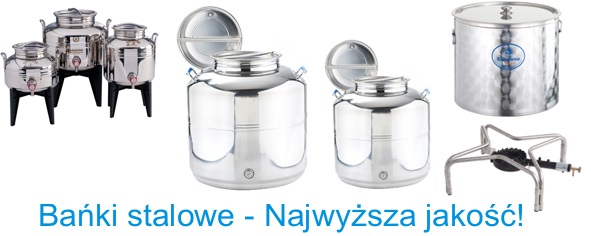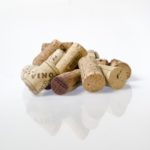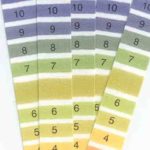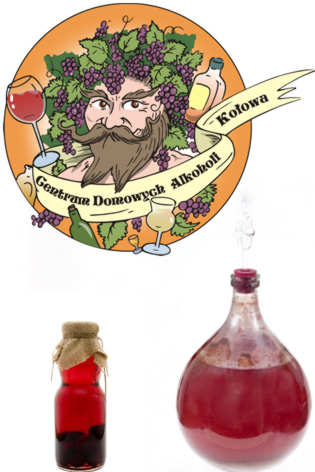Podręcznik metalurgii dla winiarzy i piwowarów

Bańki stalowe na alkohol
Stalowe zbiorniki fermentacyjne, bańki i kadzie to wspaniały wynalazek, który jednak znalazł wielu krytyków. O ile pewna część zarzutów wynika z właściwości stali, o tyle zdecydowana większość wynika z faktu, że kupujący nie do końca rozumieją, co tak naprawdę kupują.
Stal stali nierówna
Stale to bardzo duża grupa stopów. W zastosowaniach kulinarnych, a zatem również w produkcji domowych alkoholi, największe zastosowanie znajdują stale nierdzewne, co jest pojęciem już na tym etapie mylącym, albowiem nie istnieje stal, która nie rdzewieje. Stale szlachetne, bo tak należy je określać zgodnie z profesjonalną terminologią, są grupą stopów, które wprawdzie mogą rdzewieć, ale proces ten trwa długo i wymaga specyficznych warunków, a powstający rdzawy nalot bardzo łatwo usunąć, aby uzyskać ponownie doskonale czystą powierzchnię.
Oznaczenia stali
Producenci stalowych kadzi i akcesoriów stosują bardzo różne oznaczenia swoich wyrobów. Problem polega na tym, że wielokrotnie są to symbole zaczerpnięte z nieobowiązujących już norm albo całkowicie niezrozumiałe dla laików. Ponieważ każdy producent stara się zrobić wszystko, aby to jego produkty uzyskały największe udziały w rynku, całe to zmieszanie z oznaczeniami często jest wykorzystywane w celu wprowadzenia dodatkowych terminów, które są kompletnie bez znaczenia, ale marketingowo działają całkiem nieźle. W zależności od tego, na jakie akcesoria spojrzysz może to być stal chirurgiczna (czegoś takiego w ogóle nie ma), niskowęglowa (zawartość węgla w większości typów jest mniejsza niż 0,08%, a w najpopularniejszej kwasówce mniejsza niż 0,03%, stal uszlachetniona (też nie wiadomo, co mogłoby to oznaczać) lub stainless (co oznacza po polsku nierdzewną, a to już nadużycie, bo każda stal rdzewieje).
Jakich oznaczeń szukać?
Najpopularniejsze i dobre jakościowo baniaki czy kadzie będą wykonane ze stali o oznaczeniu 18/10, 18/8, rzadziej 18/0. Te dwie liczby zawsze oznaczają dodatek chromu i niklu w procentach. Chrom odpowiada za ochronę przed działaniami kwasów, a nikiel dodaje twardości i opóźnia rdzewienie, jednak jest jednym z najbardziej znanych alergenów metalicznych. Minimalna ilość chromu w stalach nierdzewnych wynosi 16,5%, ale to rzadko stosowany stop. Im większy dodatek chromu (a może on dochodzić aż do 1/5), tym odporniejsza stal.
To najprostszy model oznaczeń, jednak można często spotkać jeszcze inne: AISI 304, czyli standardowa stal szlachetna, najczęściej używana. To dobra jakościowo stal, którą wykorzystuje się praktycznie wszędzie, gdzie środowisko nie jest nadmiernie kwaśne, a więc na przykład w przemyśle spożywczym. Podobna do powyższej jest stal AISI 321 oraz różne typy AISI 316, ale te ostatnie są przeznaczone raczej do produkcji przedmiotów poddanych działaniu agresywnych związków chemicznych i wysokich temperatur, zatem jako tworzywo do budowy beczek, kegów itp. są trochę jak armata na muchę, ale zdarzają się pojedyncze przypadki ich używania. Dodatek tytanu oznaczany literami Ti lub T w różnych typach symboli nie jest wymagany – zmniejsza ryzyko tworzenia węglików, które w standardowych warunkach domowych i tak jest nikłe.
Podsumowanie
Każdy producent zastosuje na swoich wyrobach oznaczenia, jakie tylko uzna za stosowne, jednak niestety większość z nich jest całkowicie bezużyteczna, ponieważ nie można odnieść ich do żadnych znanych standardów. Mam nadzieję, że krótka ściągawka z metalurgii i technologii materiałowej przedstawiona w tym artykule rzuca na sprawę trochę światła i kolejny wybór kadzi stalowej będzie podyktowany jej rzeczywistymi zaletami, a nie skutecznością zabiegów marketingowych.







